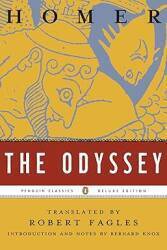
Ios / Ίος
A Few Days on Ios
Here we are at the port of
Ios, one of the Cycladic islands
at the center of the Aegean sea.
We're at the port looking up to Hora,
the main settlement of the island,
overlooking the port.
In the "shoulder seasons" of mid-April through May,
and September through mid-October,
Ios is a very pleasant place to visit.
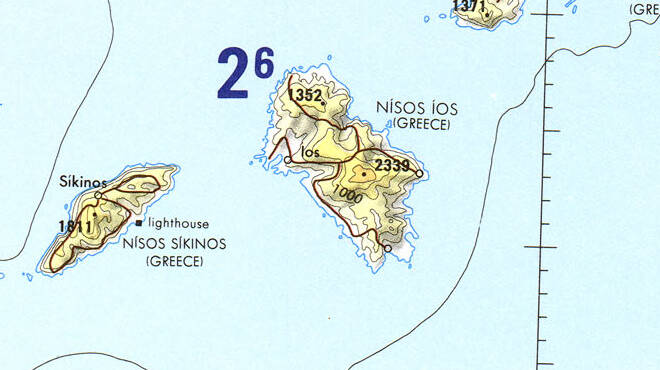
Portion of Tactical Pilotage Chart G-3B from the Perry-Castañeda Library Map Collection at the University of Texas at Austin.
Find Your Lodging
Guesthouses at Booking.comI stayed at the Avra Pension, it was great. Very nice accommodations, friendly and helpful staff, and a perfect location.
Walk off the ferry and along the pier to the traffic circle with a bust of Homer; turn right and walk past a restaurant and café, then turn left, away from the water, and walk one block back a narrow lane.

Starting the Day
Here's the view from my balcony. There's the harbor, and in the distance is a church overlooking the harbor entrance. I will visit that church, but first, breakfast. I will walk out that lane to the water, and then the café is right at the corner.
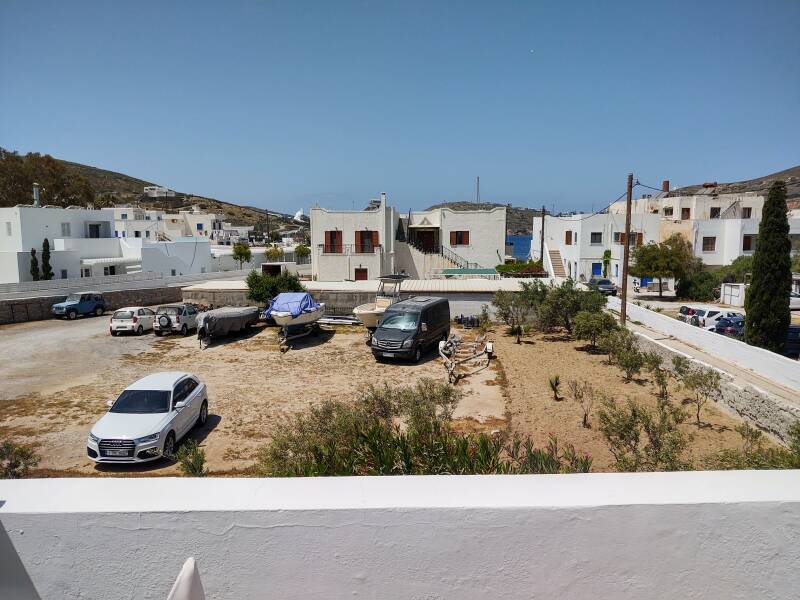
Here's the view out the front of the Sailing café. A small ferry is pulling away from the pier.
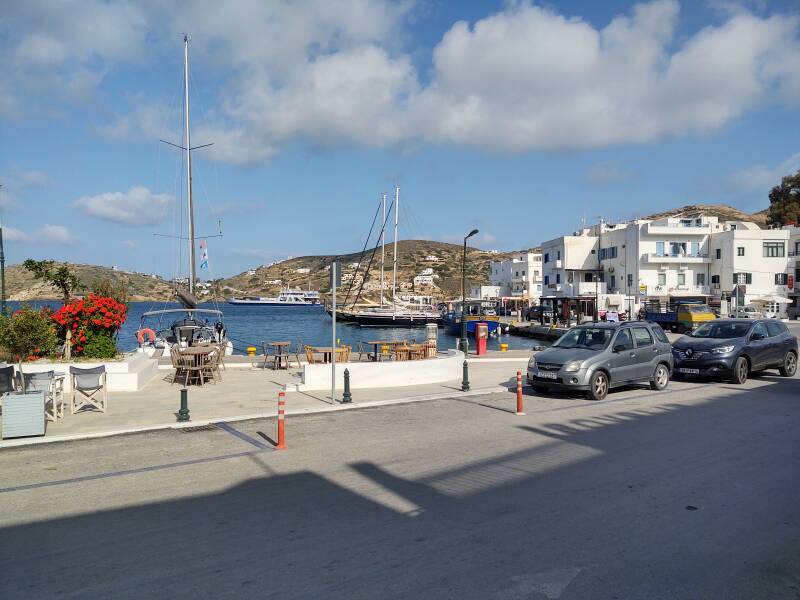
An omelet with tomatos, peppers, onions, and feta, plus a salad. A salad at breakfast, I like that. I also encountered that frequently in Japan.
And toast with butter, and a double Greek coffee.
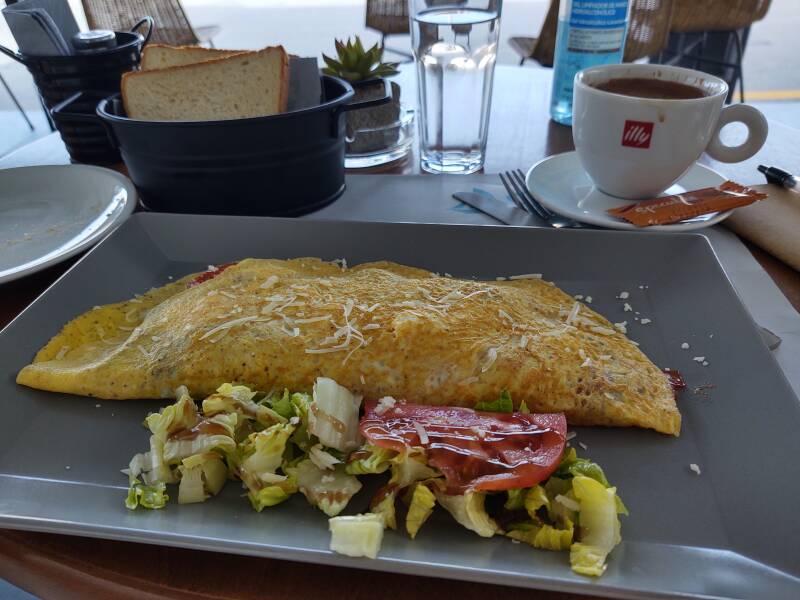

A large ferry visits the Ios port.
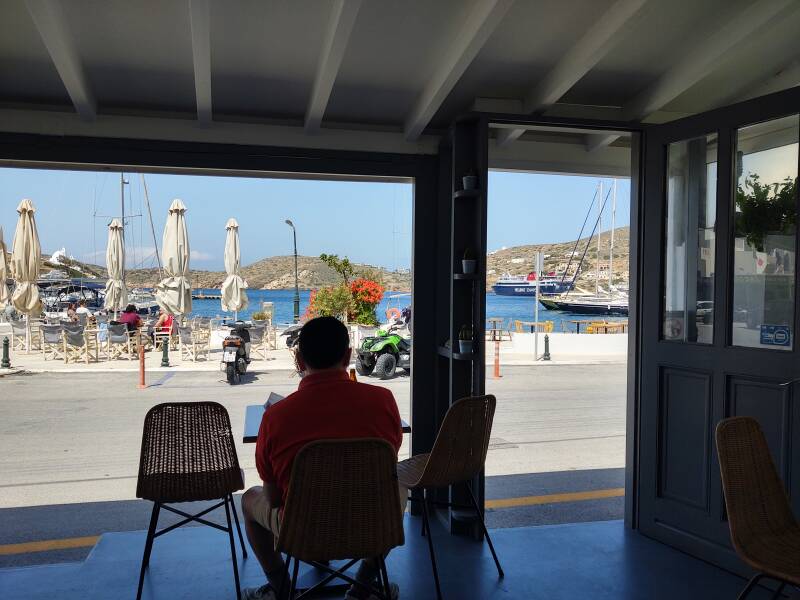
After more coffee, it was time to move on. I was going around the side of the port where the fishing boats tie up, opposite the ferry pier.

Looking back, there's a nice view of Hora and the port.
Greece has complicated geology, as it's at the junction between the Eurasian and African tectonic plates. Today's Cycladic Basin at the center of the Aegean was once all sedimentary stone. Pressure and temperature changed much of that to metamorphic stone, which is what most of Ios is now formed of.
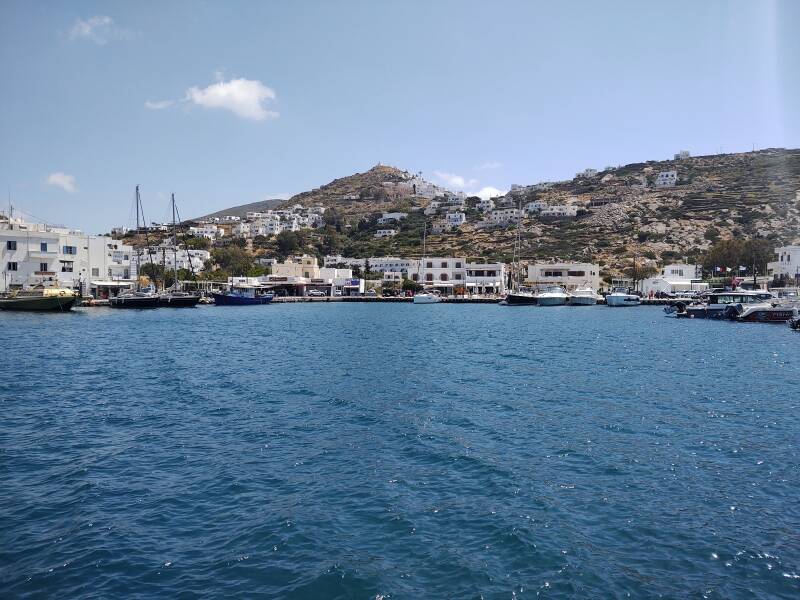
Tectonic movement wrinkled the basin into mountains, as the African plate has been driving its way beneath the Eurasian plate. Some of those submerged mountains are volcanos, including Thira and Milos. The Aegean islands are the tops of submerged mountains. The southern Aegean is still one of the most rapidly deforming regions through the entire Himalayan-Alpine mountain belt.
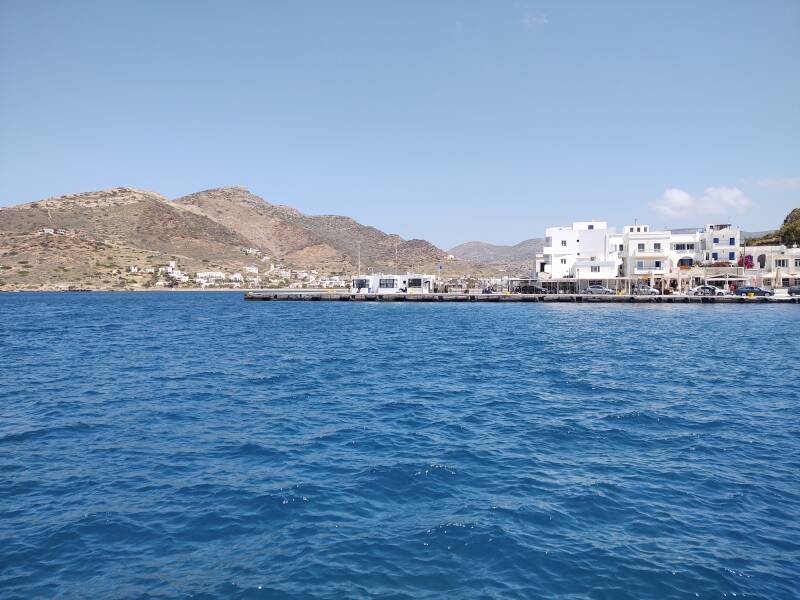
The peak above Hora is about 140 meters high. Beyond it is Προφήτης Ηλίας or Prophetis Elias at 490 meters. Elias, called Elijah in English, is associated with mountains. An isolated chapel on a peak is likely dedicated to him.
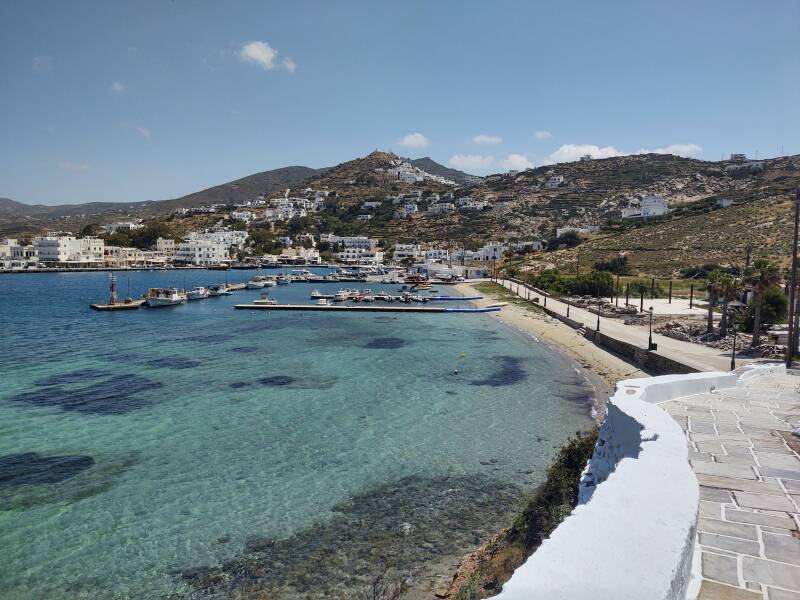
Ios has this great natural harbor, one of the best in the Cyclades island group. Ios became an important port in prehistoric times, a place to stop when traveling between the mainland and Crete. I visited a Cycladic era settlement from the middle of the third millennium BCE, seen further down this page.
Ios was influenced by the Minoan civilization, and then the following Mycenaean civilization. The Phoenicians likely had a presence here until the 9th century BCE.

I reached that prominent church overlooking the harbor. It's on the point where the bay coming in from the Aegean turns to form the inner harbor area.

Ios is famous for having many churches and chapels, with one tally counting 365. That's not at all surprising, although 365 being one for every day of the year is suspicious, too good of a story not to adjust the count to that specific number.
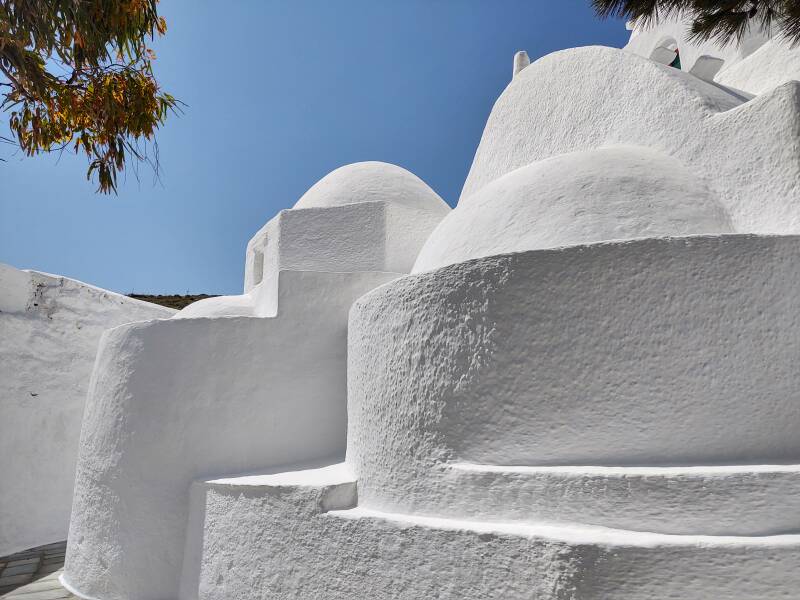
The population was 2,024 at the 2011 census, down from 3,500 in the 19th century. It declined steadily from the 1940s to the early 1970s. 365 churches and chapels for 3,500 people would be one for every 9.6 people, 365 for 2,024 people would be 5.5 people for every church or chapel.
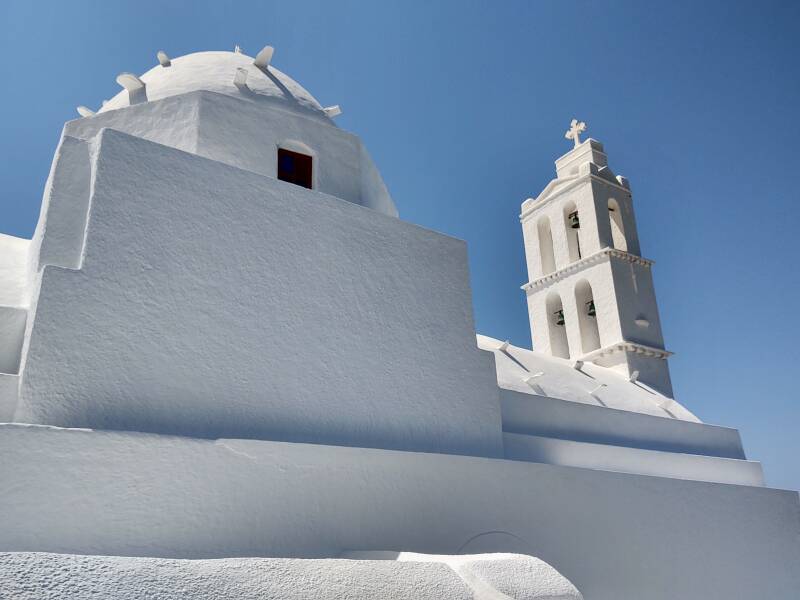
On Folegandros with its 765 inhabitants, I counted 51 churches and chapels on the map in the town square, giving it at least one church or chapel for every 15 people. If that count of 365 on Ios is correct, that would mean that Ios has more per capita but not implausibly so.
It's Greece. Of course there are a lot of churches.
From the end of the courtyard around the church you can see the bay's opening into the Aegean.

Ios was an important place in Classical and Hellenistic times. But then it began to decline with the Roman occupation, during which it was used as a place of exile. That continued during Byzantine times, and on into the Ottoman centuries.

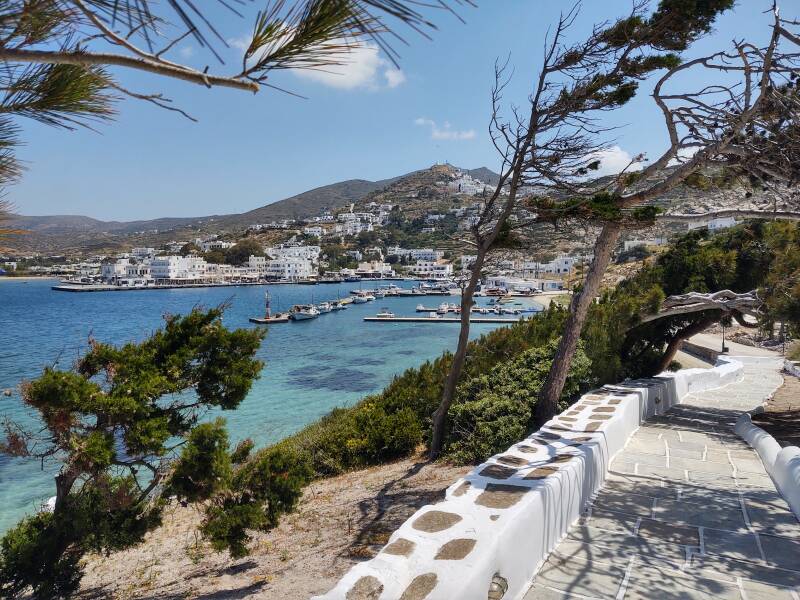
A High-Speed Ferry Arrives
I was walking back down to the port when I heard a rumbling. A high-speed ferry was arriving.

These SWATH or Small Waterplane Area Twin Hull ferries move fast across open water, at 50-54 kph.
They're also highly maneuverable, with fully steerable water jets.
And, they often make very brief port calls. Let's see how long this one takes, using the image timestamps.
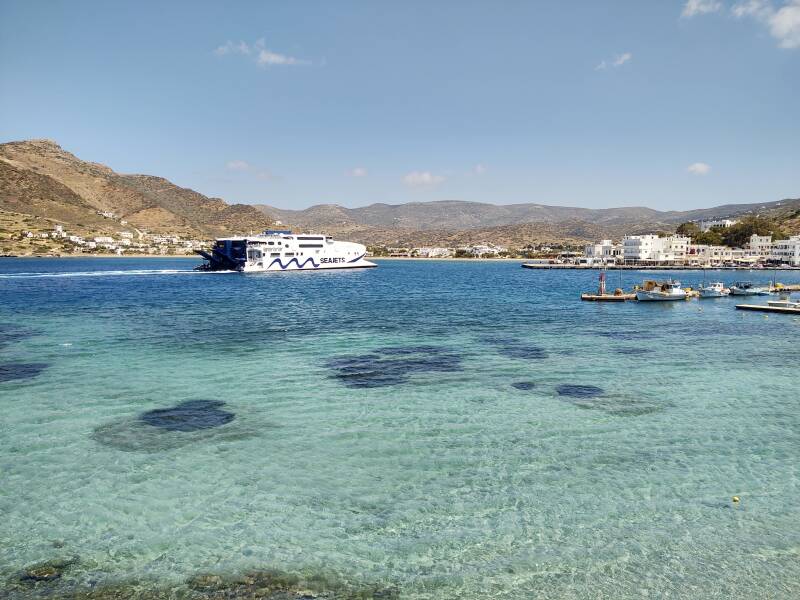
12:02:15 — The ferry maneuvers into position.

12:03:30 — The ferry ramps touch the pier.

12:03:59 — Vehicles and passengers are unloading and loading.

12:05:57 — The ferry ramps are rising as the ferry pulls out. The ramps were on the pier for less than two and a half minutes, and this stop involved unloading and loading a few vehicles in addition to passengers. I am impressed.
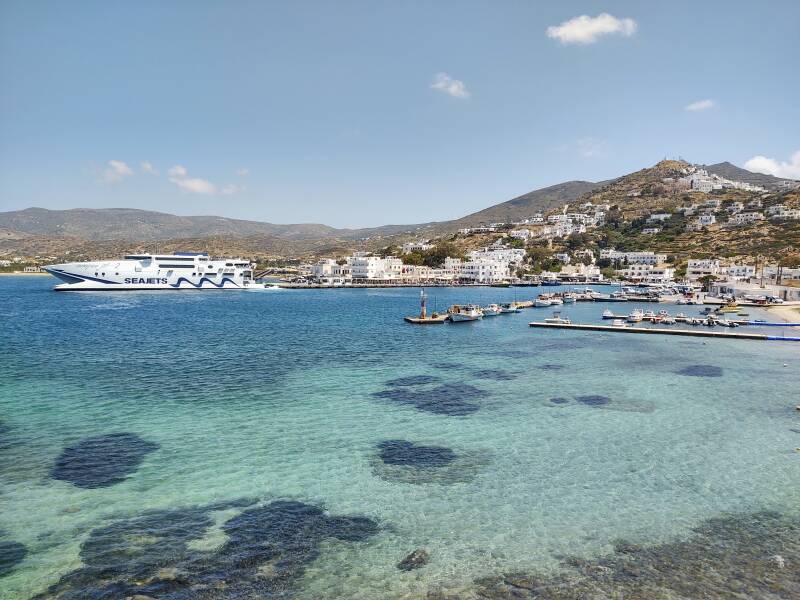
The ferry accelerates across the harbor.

The ferry is accelerating out of the harbor. Only eight to ten minutes elapsed from when I first thought I heard something coming to when I took the below picture.
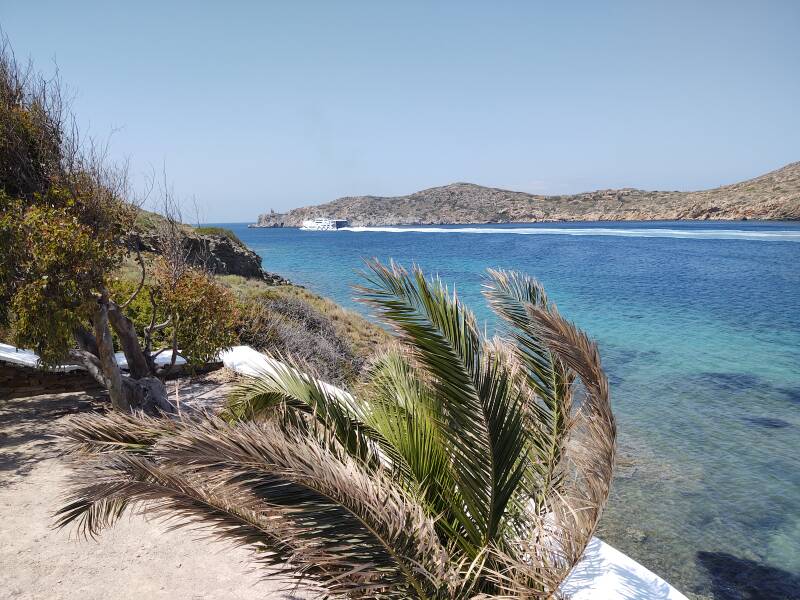
Now I returned to the port, past the fish market, the supermarket, and a nice taverna.
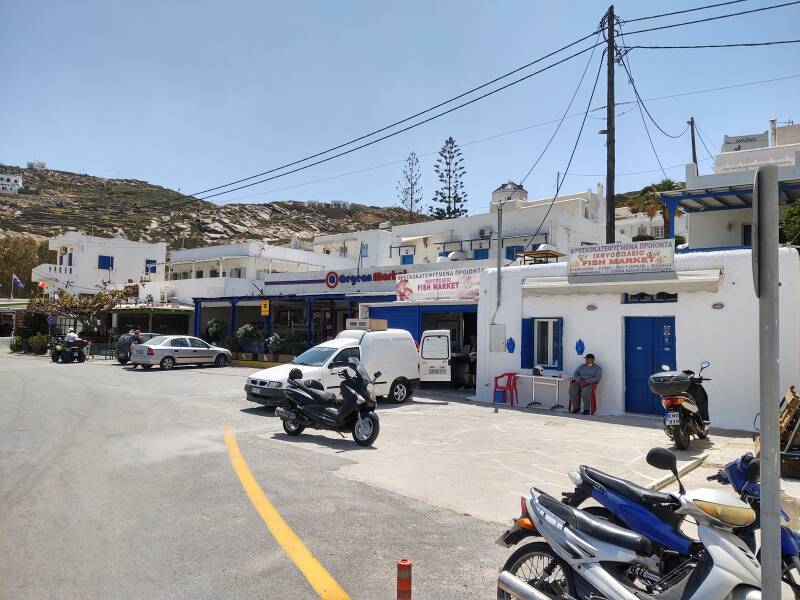
Homer
Ios is associated with the epic poet Homer, because of the legend that he died on Ios. Of course there's an argument that Homer himself was a legend.
VisitingDelphi
The general form of the legend is that Homer died on Ios because he disregarded what he was told by Pythia, the high priestess at the Temple of Apollo at Delphi. Homer had gone to consult the Oracle of Delphi to learn about his parents and his origin. She said, as cryptically as always:
Your mother's home is the island of Ios, which will accept you when you die, but you should be careful of the enigma of the young children.
Great, a notoriously cryptic oracle warning about some enigma. Who knows what this will lead to.
Homer went to Ios anyway. He saw some children fishing, and asked them what they caught. They said:
Whatever we get we leave it and whatever we don't get we take it with us.
Yes, that's pretty enigmatic and Homer didn't solve the riddle. The children were talking about lice — those who found lice on their body killed the lice and left them there, while those who didn't find the lice (but of course had them) went away with lice in their hair.
Version #1 of the legend says that Homer remembered the Oracle's warning, panicked, and ran away. He slipped on the muddy road and fell, hitting his head and dying almost instantaneously.
Version #2 says that Homer died of sadness because of his inability to solve the puzzle.
Version #3 says that he was already seriously ill, and went to Ios because he knew he would die there.
Ios minted its own coins from the mid-4th into the 2nd century BCE. The coins depicted Homer, or a palm tree which grew on Ios, or Athena as she was worshiped on Ios.
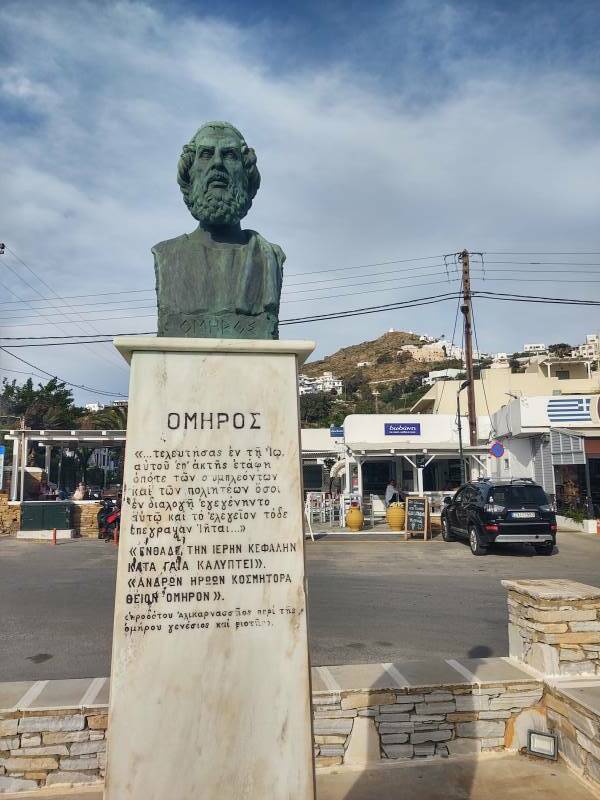
Now his name is written Όμηρος and pronounced OH-mee-ros. In his day there was "smooth breathing" and "rough breathing", and his name was written Ὅμηρος with that little added "rough breathing mark" and pronounced HO-mee-ros. But no "H" today. The same for Herakles, Hera, Hades, and so on.
A Dutch count named Pasch di Krienen came to Ios in 1771 looking for Homer's grave. He found a few candidates with the help of locals. He became sure that one of them must be Homer's but then noticed grammatical mistakes in the inscription. Then he found even more purported Graves of Homer at various locations around Ios. After spending a lot of time and money, he abandoned his search.
To Hora
The easy way to reach Hora is by taking the bus that leaves from the traffic circle around Homer's monument.
Of the 2,024 people living on Ios at the 2011 census, 1,754 of them lived in Hora.
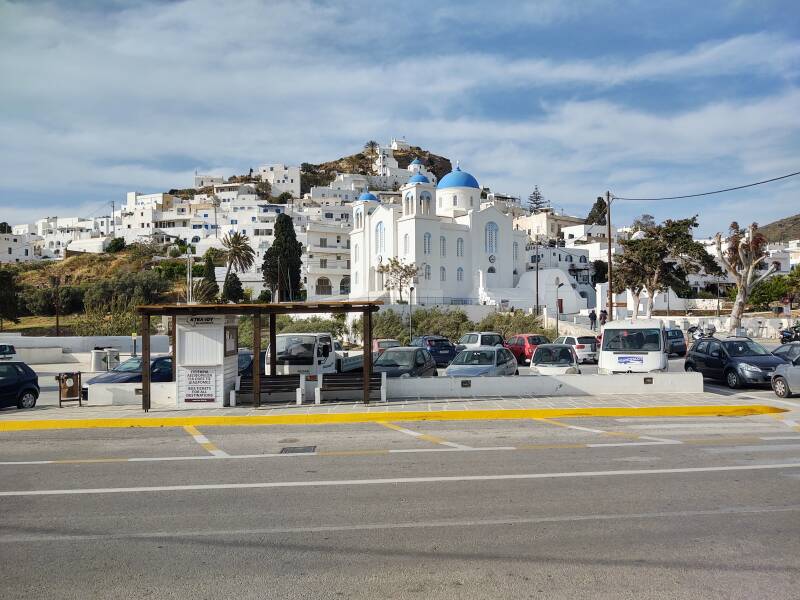
The Church of the Annunciation dominates the large open square. Other smaller churches are found in the passageways plus a series of three small ones leading to the peak.
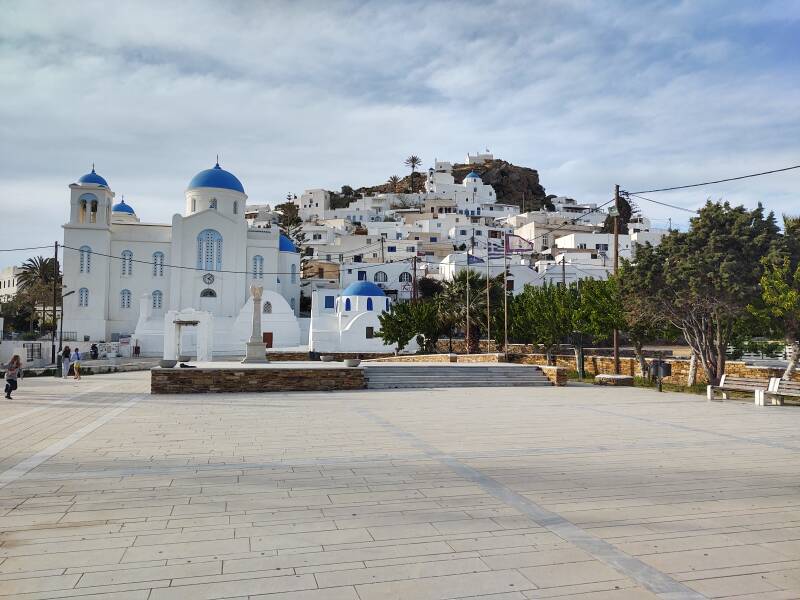
Public clocks in Greece are seldom anywhere close to correct. This picture was taken at almost 18:10, so this clock on the large church is either almost two and a half hours behind, or a little over nine and a half hours ahead.
I don't know why people here even own clocks, there seems to be no point.

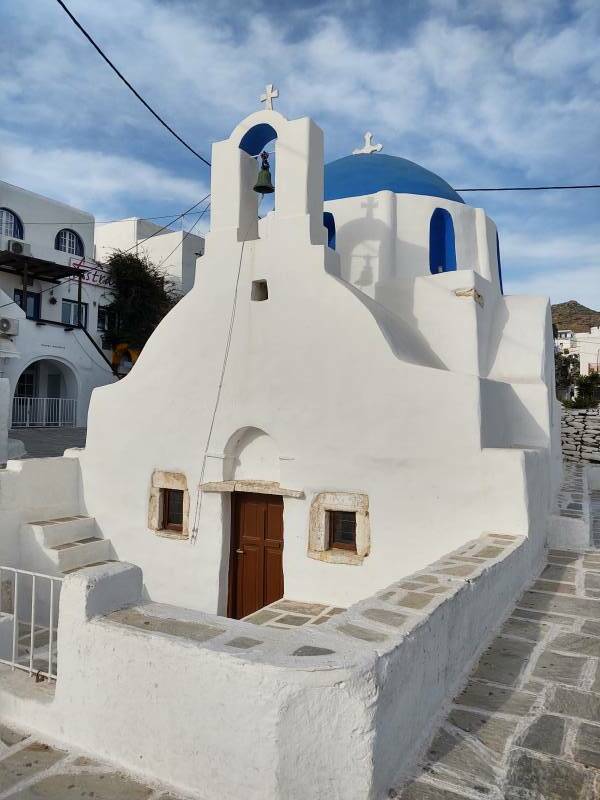
The passages through the old upper part of Hora are marked as streets, but hand carts are the only possible vehicles.
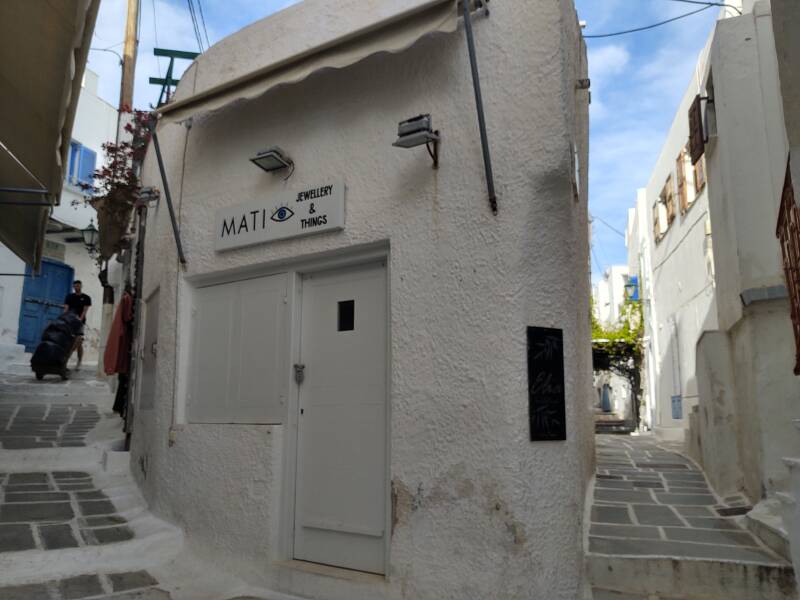
The central passage through Hora is the tourism corridor.
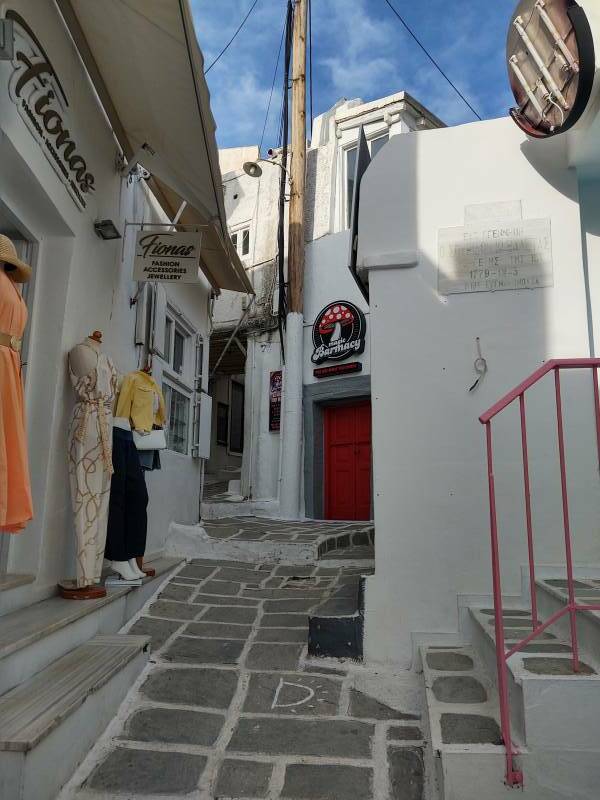
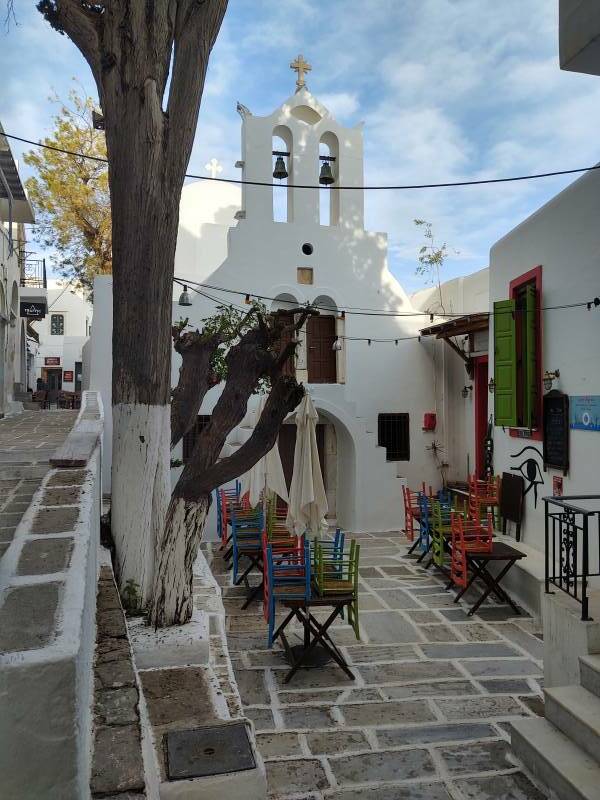
Restaurants, bars, boutiques, and discothèques. Plus, of course, some small churches.

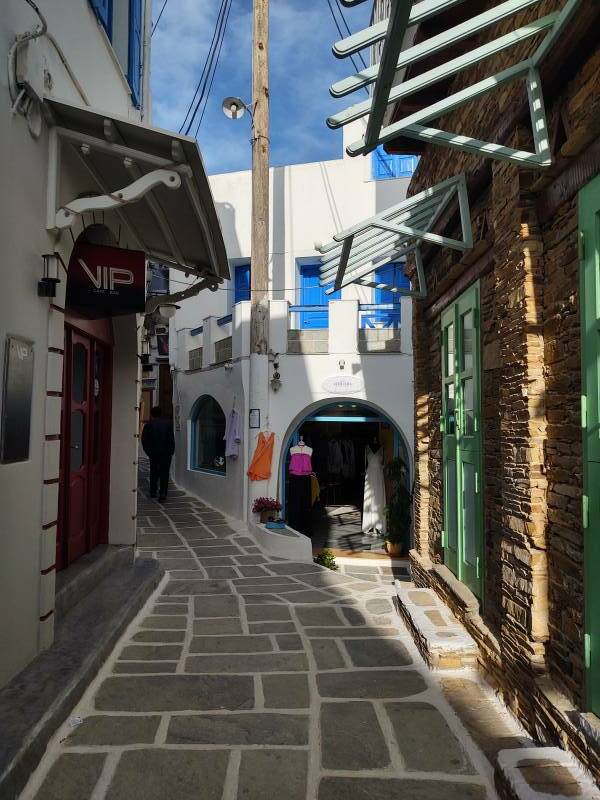
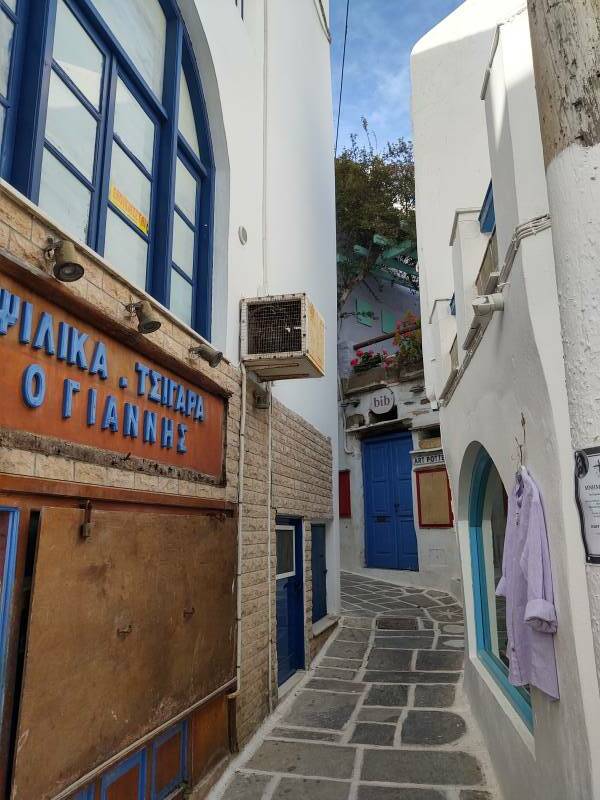
Off the main corridor it's all residential or ecclesiastical.
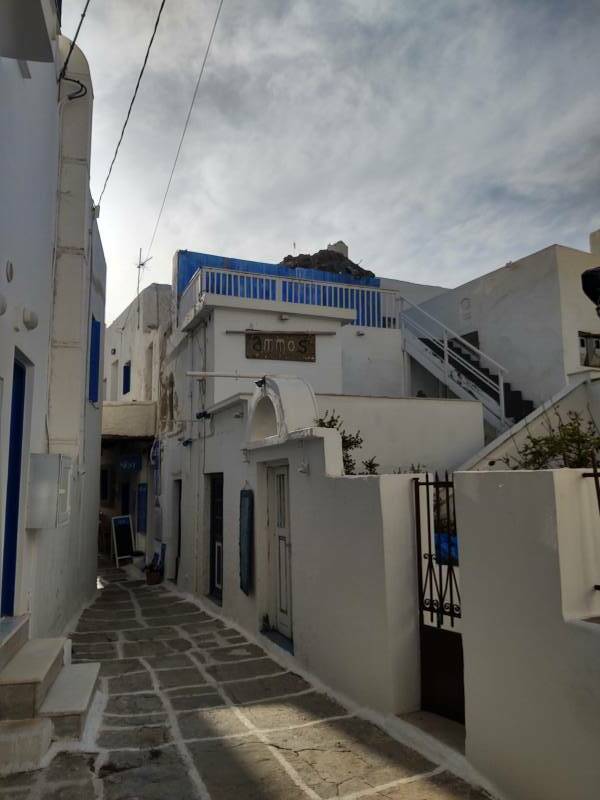
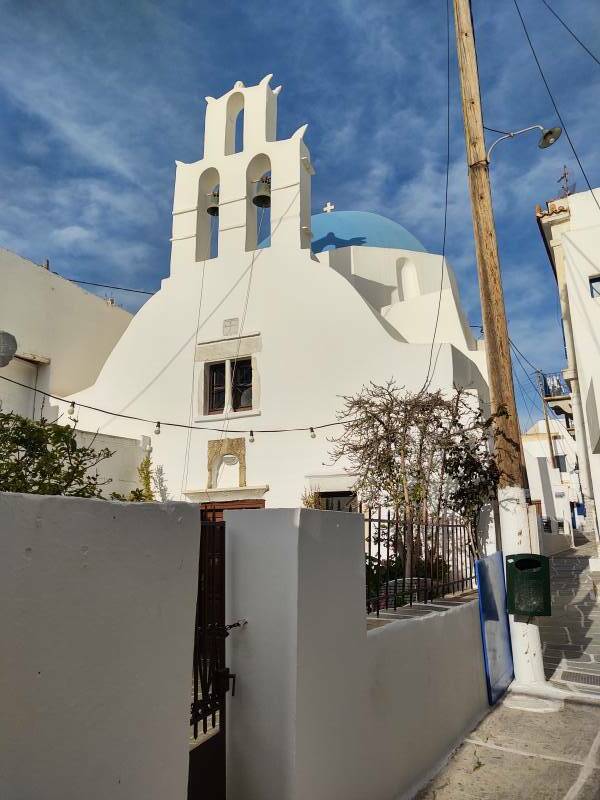
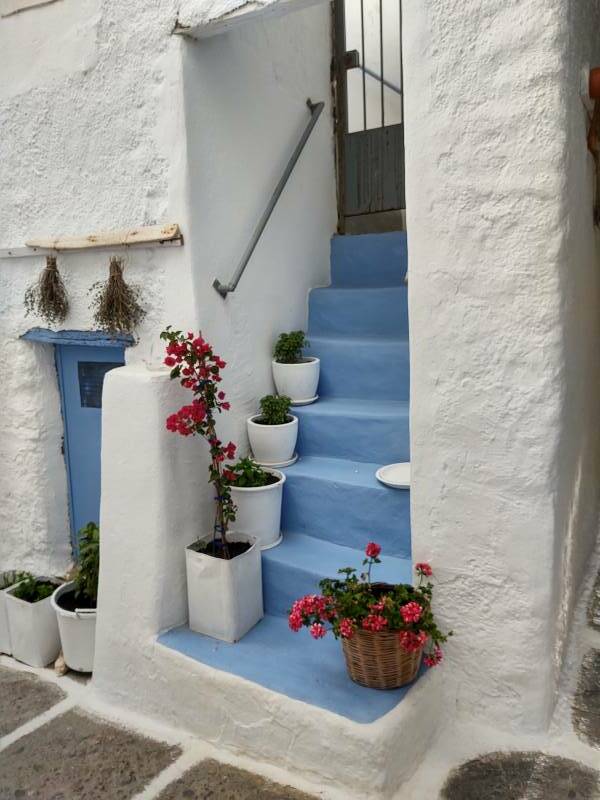

Make your way past the drying laundry.
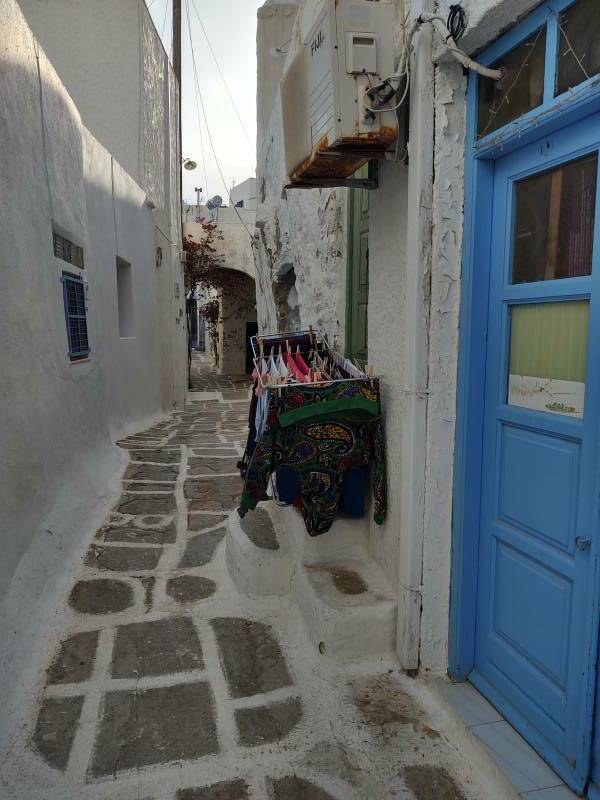

Your path is mostly closed in. You get just a tiny glimpse of the horizon here and there.
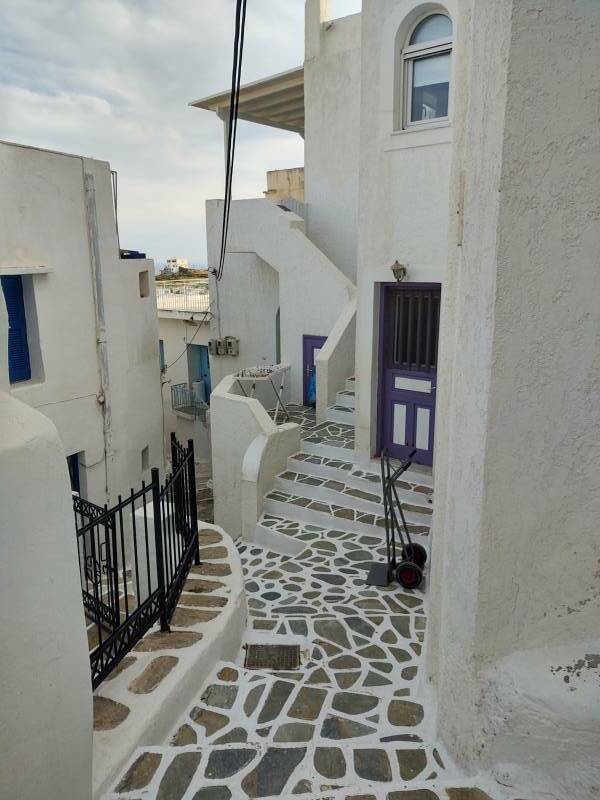
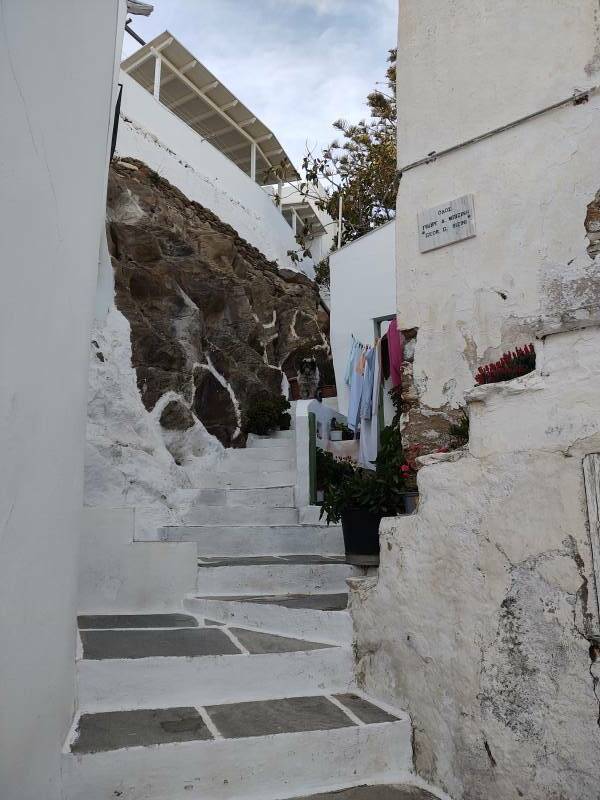
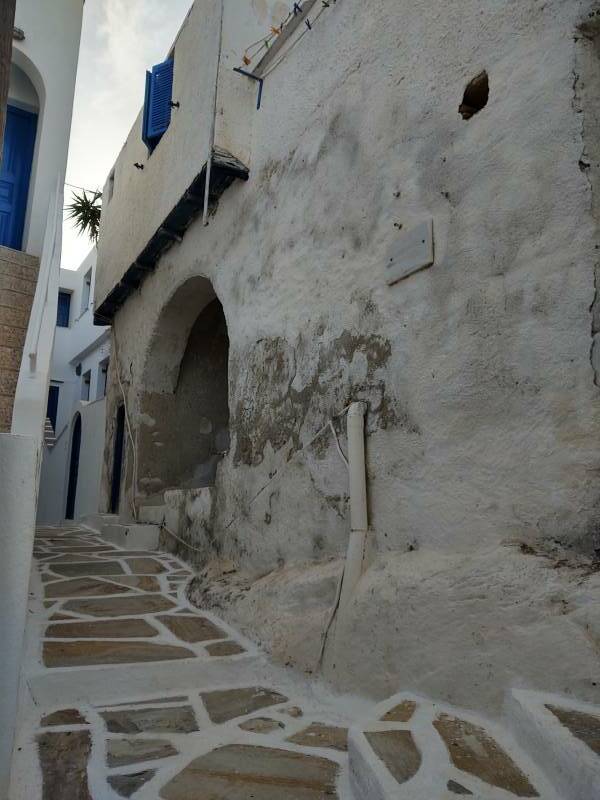
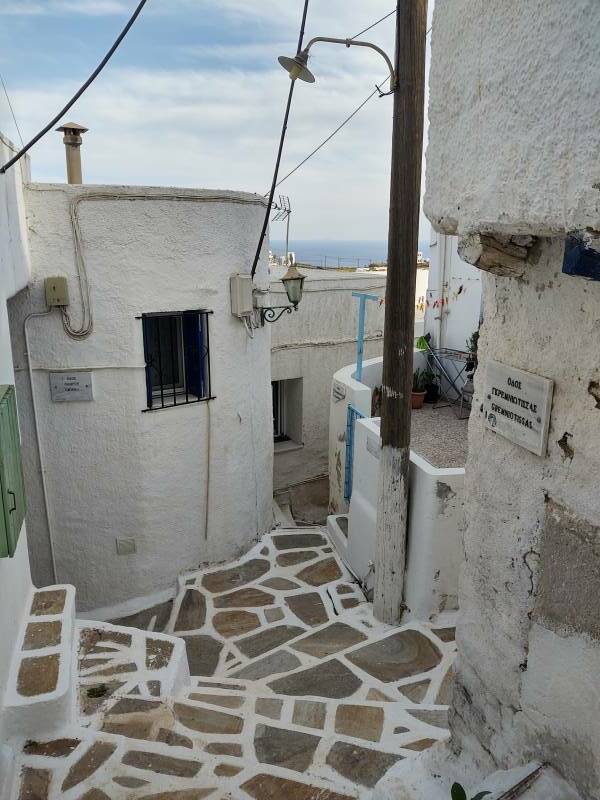
The thoroughfare passing left to right through the intersection seen above is marked as ΟΔΟΣ ΟΜΗΡΟΥ, Street of Homer.
In 1827, just a few years after Greek Independence, the local leaders of Ios wrote a letter to the national government asking for a school to be established here.
The first school was opened in the 1850s, teaching a small number of students of all ages. It was an elementary school with some basic high school courses. Most students didn't graduate as they were kept busy helping their parents in the fields.
A proper elementary school opened in 1936, the first kindergarten in 1972, and the first full high school in 1980.

I'm headed down the steep footpath to the port. Surprisingly, the Safran is one of the very few restaurants, cafés, or bars in Hora with a view down over the port and toward the sunset.
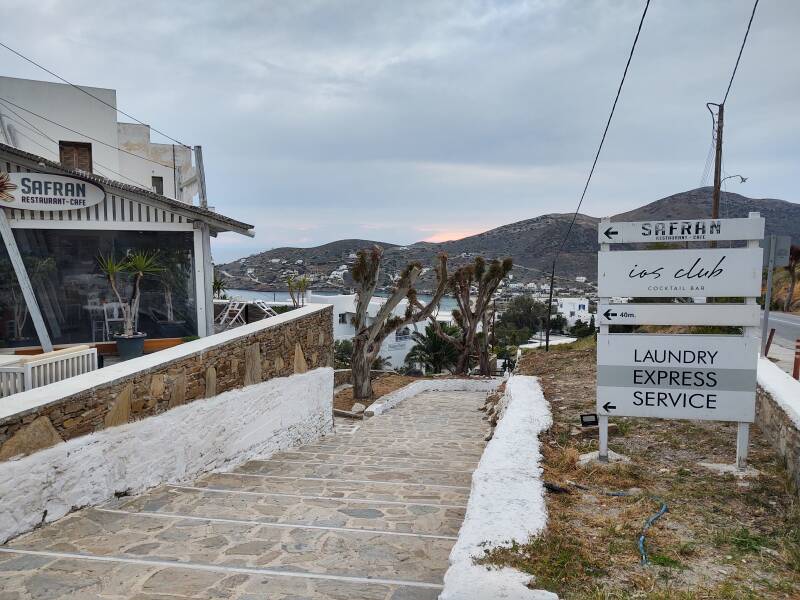
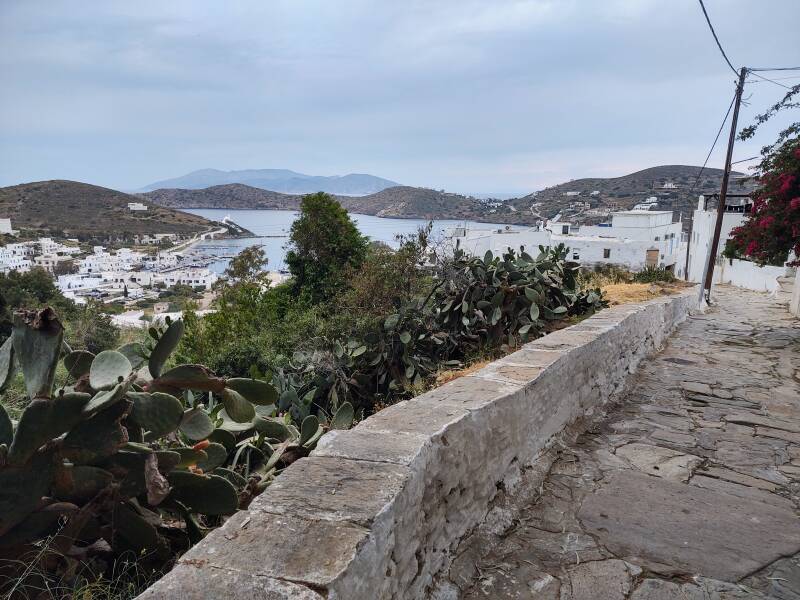
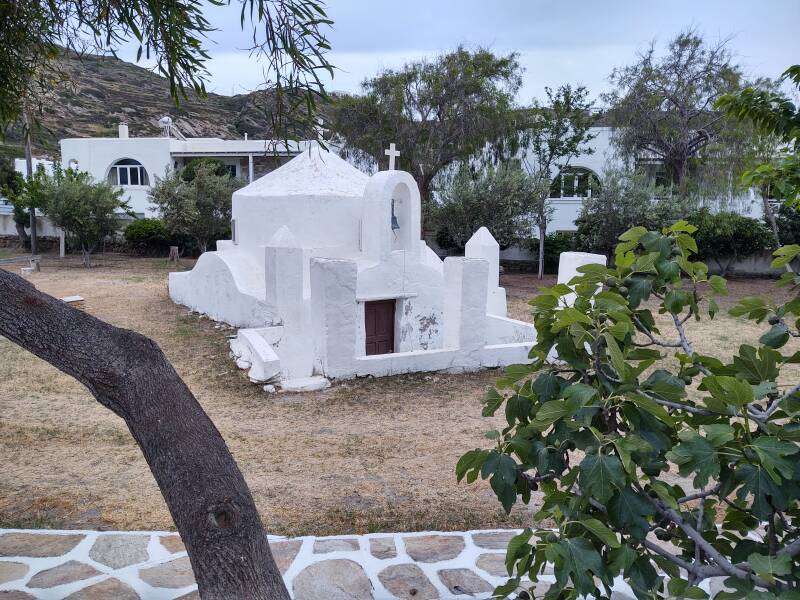
Skarkos
Skarkos is an early Bronze Age settlement a short distance inland from the port. A colorful line of beehives lines one of its outer walls.
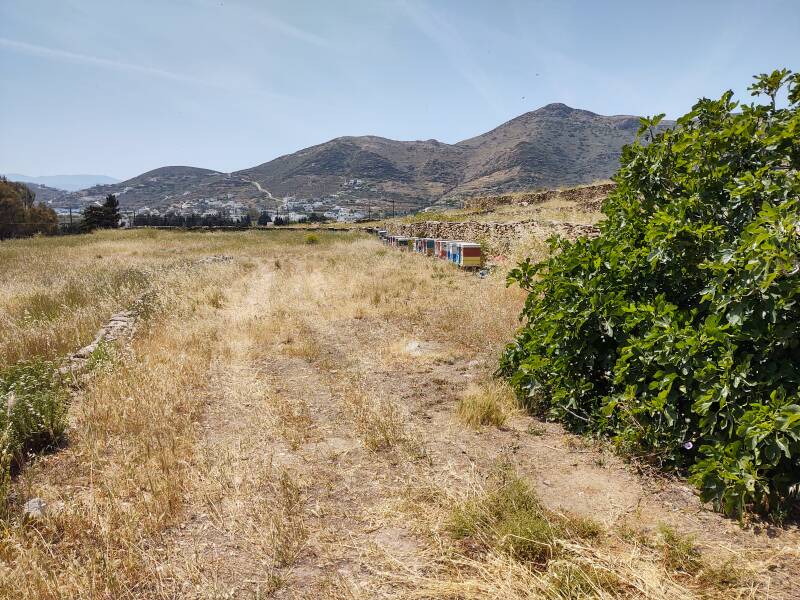
It dates back at least to the mid-third millennium BCE, when it was an important early settlement of the Cycladic civilization.
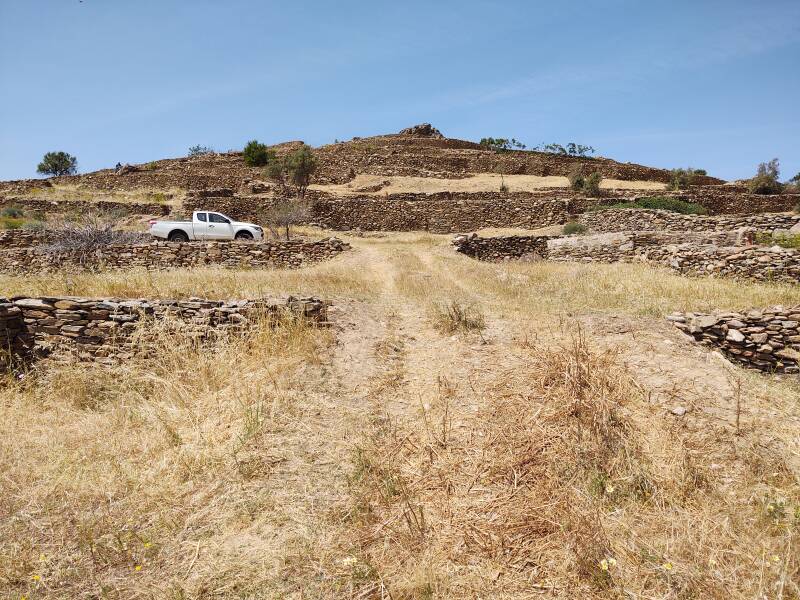
Riding the bus up to Hora you will see a sign part-way up pointing to the Skarkos site. It's one of the distinctive yellow-on-brown signs used to indicate sites of historic or cultural importance.
But to get there on foot, don't climb part-way up to Hora and then back down again. Look on a map, or Google Maps, or ask the way.
First, go along the waterline past the ferry terminal, to the beach:
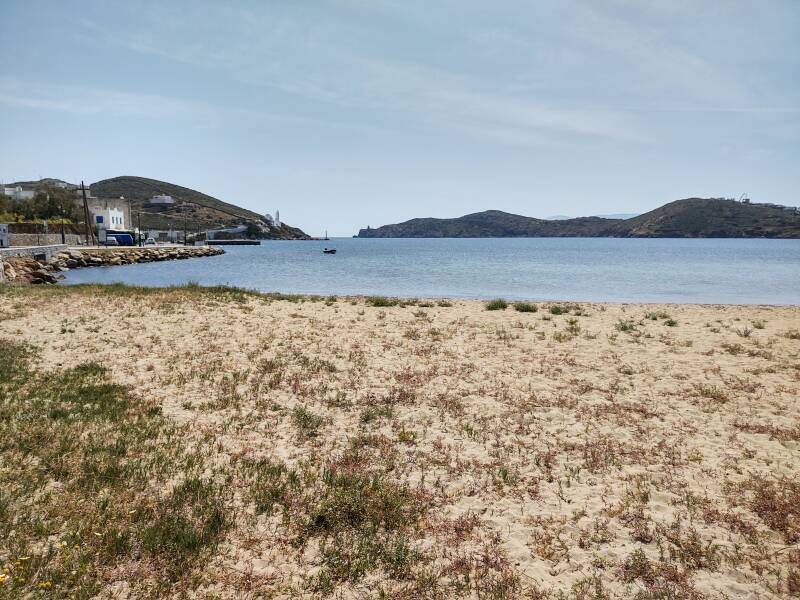
The medical clinic is across the road from the beach. Continue past the clinic, to the left in this picture, then follow a small road inland while keeping Hora on your right.

Now we're at the entrance to Skarkos looking back at Hora.
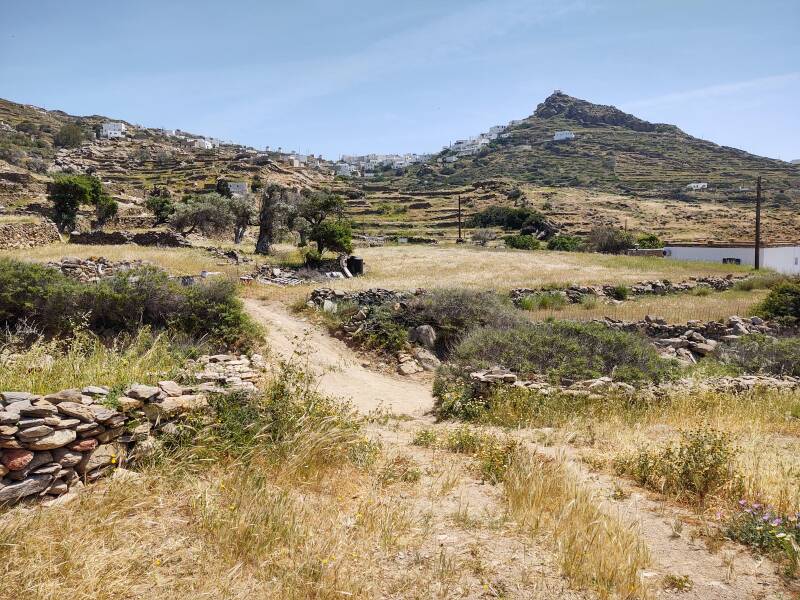
Skarkos is just inland from one of the best harbors in the Cyclades island group, and it's close to the island's most fertile farmland. Given the steep and rocky terrain of most of the Cyclades group, that makes this a great location.
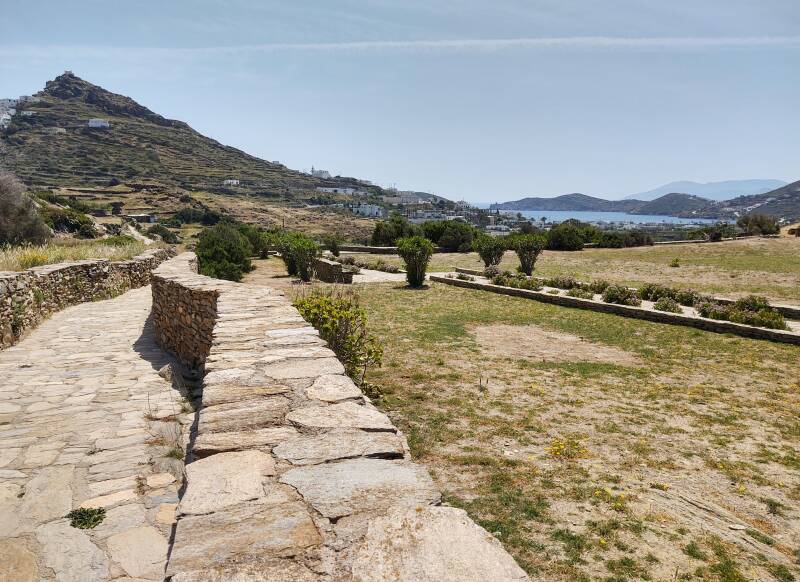
Skarkos is very well preserved, making it one of the most important prehistoric sites in the Cyclades. What you see here are the structures, artifacts are in the museum in Hora. The site was systematically excavated and analyzed on its north and east sides in 1984–1997.
Skarkos is the largest and best preserved site of the Keros-Syros culture. At its peak in about 2700–2300 BCE, this culture had trade relations with the Greek mainland, Crete, and Asia Minor.
The finds include small artifacts such as the distinctive Cycladic style marble figurines. Seals were found, along with their marks on pottery, indicating that the residents organized their agricultural production and distribution. There were also items made from obsidian, ceramic, marble, stone, bone, and seashells.
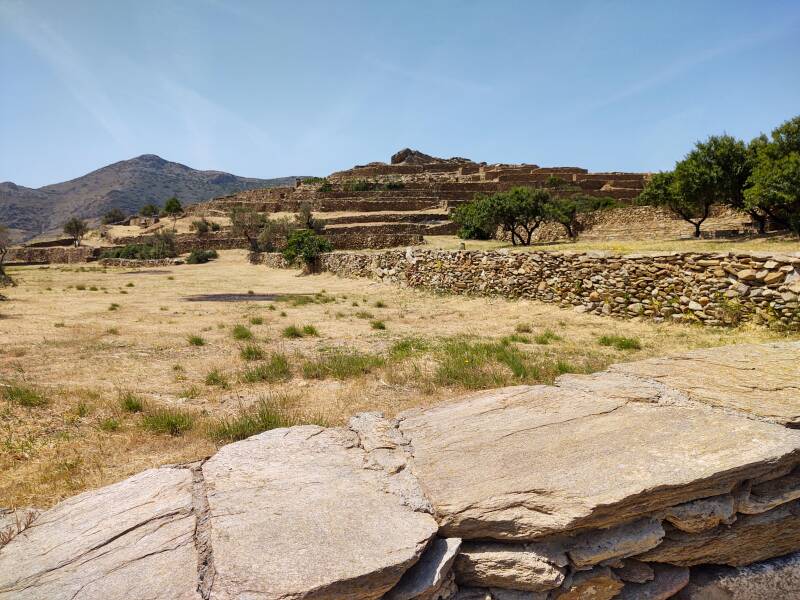
Pithoi or large clay storage jars 1 to 1.3 meters tall were used to store agricultural products. Smaller clay amphorae held liquids — wine and olive oil.
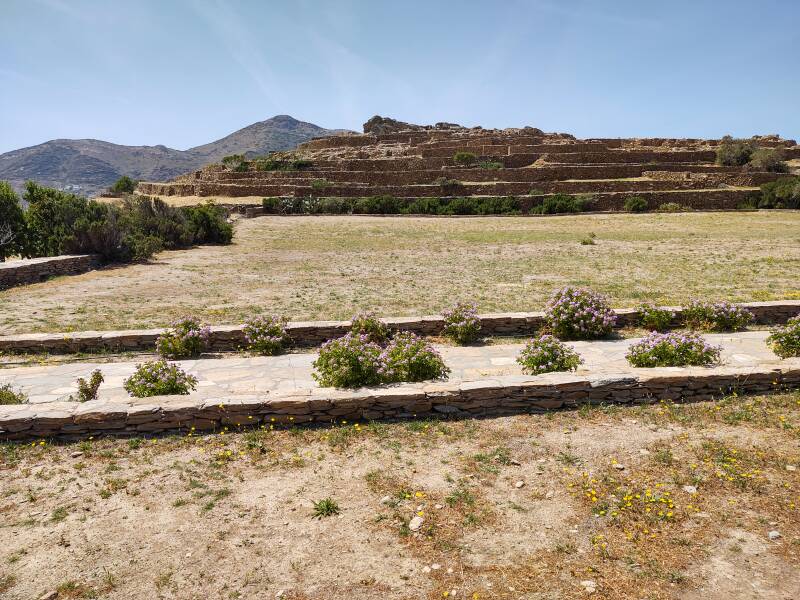
The settlement of Skarkos has walls up to four meters tall surrounding buildings of one and two stories. Typical residences had two stories and an enclosed courtyard. Streets were one to two meters wide, and there were open public squares. The settlement was estimated to have been the home of 200 to 300 people.
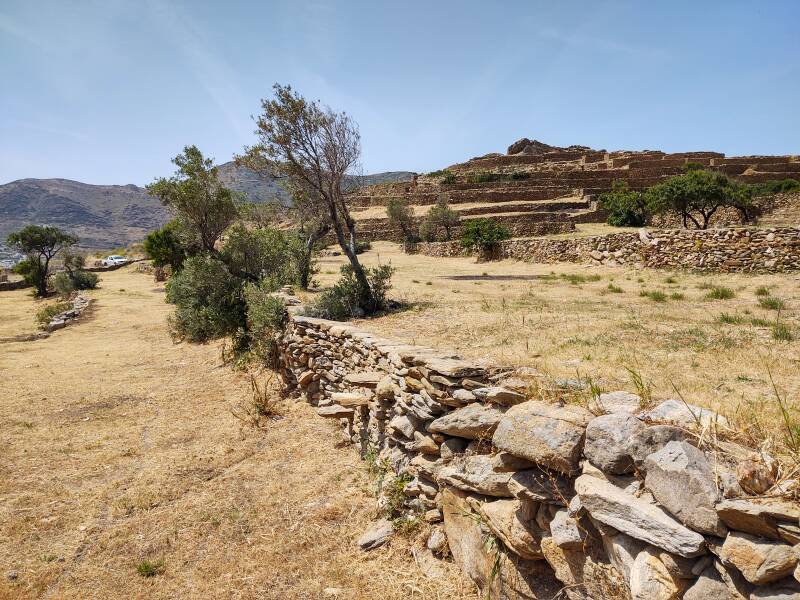
Around the Port
The square just in from the ferry pier has some cafés and travel-related businesses.

Just past that is the traffic circle — Homer and the bus stop for the ride up to Hora.
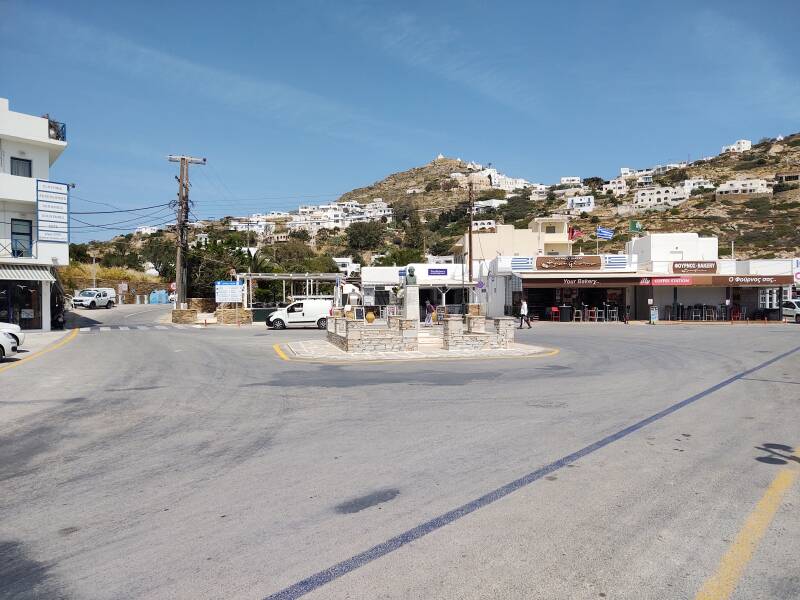
There's a bakery and mini-mart at the traffic circle. Then continuing on, the Ithaka restaurant and the Sailing café.
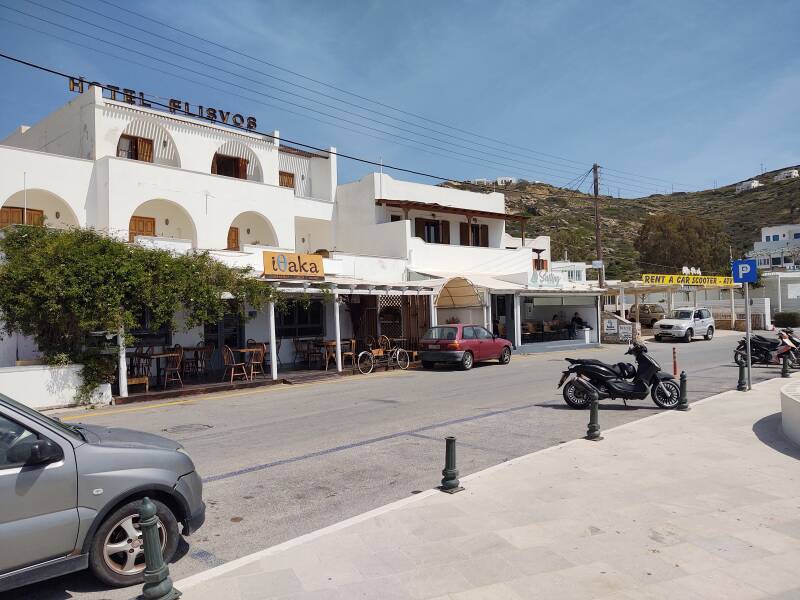

Dinner at the Waterfront
The sunset can be pretty nice at the port, even if the western horizon is behind the land on the far side of the bay.
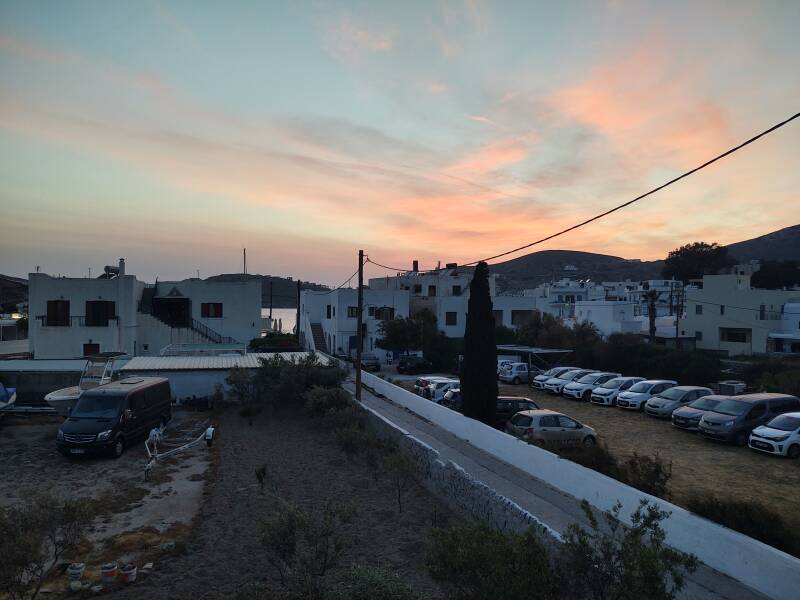


The Enigma taverna is a nice place to get dinner at the port.
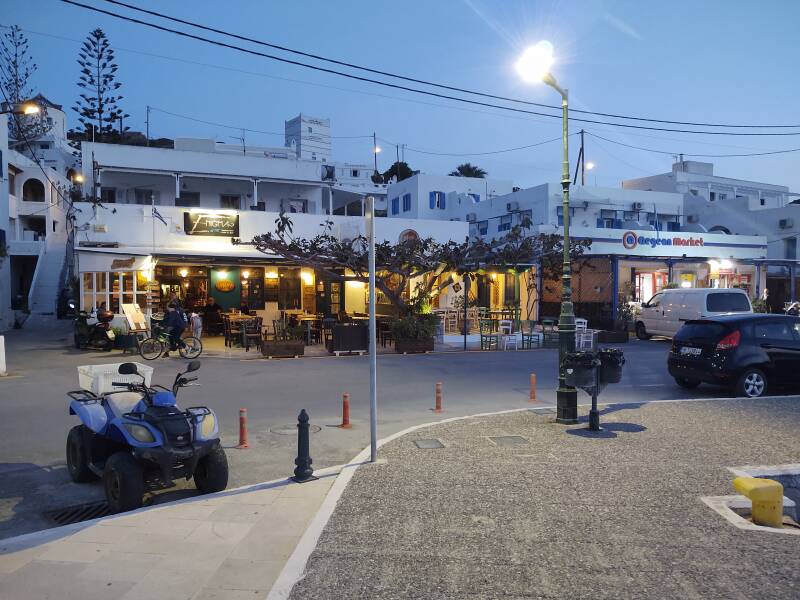
There is seating indoors if it's a cooler evening.
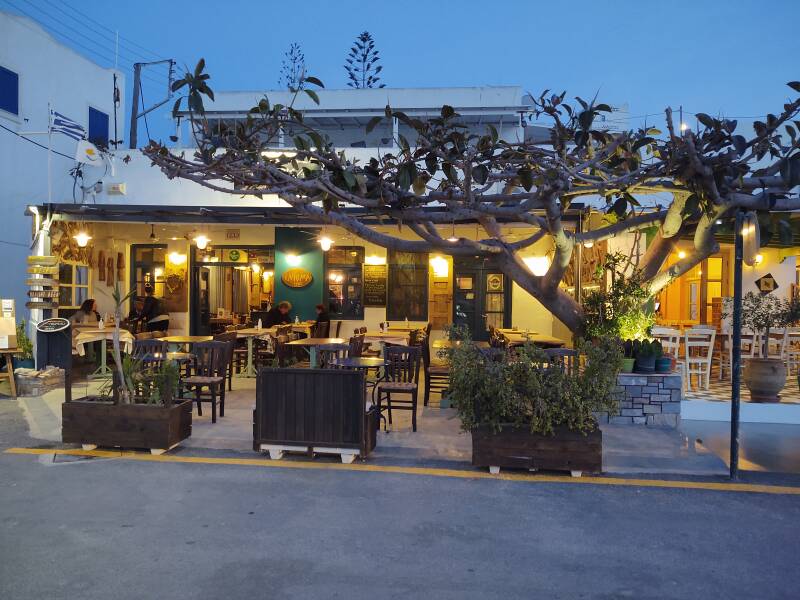
Outside, you're right at one corner of the harbor, looking across to the traffic circle.
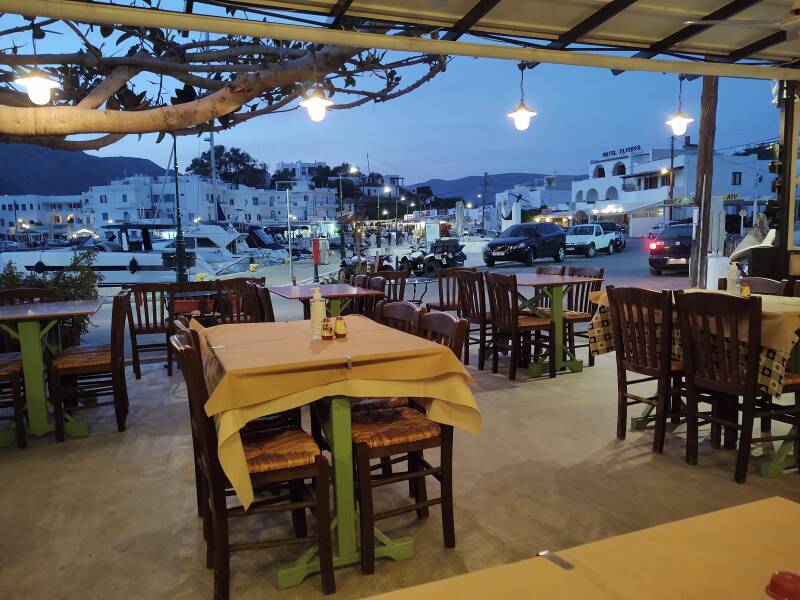
Many of the patrons will be local. Probably most of them during the shoulder season.

They had freshly caught tuna, grilled medium-rare, with an eggplant dish much like baba ghanoush. Some sliced avacado and a green chile sauce.


The "Party Island" Legacy
Ios got a reputation as a center of debauchery. Through the 1960s and into the 1970s, young travelers would party into the night and then camp on the popular beach of Mylopotas.
Nowadays, Mylopotas is a mass package tourism resort where middle-aged Brits and Germans demonstrate how long-term sun exposure dessicates heavily tattooed skin. Yikes.
Ios still has a party atmosphere, of sorts, in Hora during the high season. However, the debauchery of the 1970s has been replaced by a far more sordid version driven by cheap flights from Britain to Greece.
The "party center" of Ios is a cluster of a few small windowless bars in Hora that cater to binge-drinking English tourists. Sky Sports on the TV, Australian-accented bartenders, everything to make the English feel like they're still in Blighty.
Guesthouses at Booking.comListings at Booking.com for accommodations throughout Greece routinely warn that "bachelor(ette) parties" are not allowed, and attempting to sneak one in anyway leads to immediate eviction and several financial penalties.
1: In the Dutch sense, meaning THC in addition to caffeine and theobromine. Coffee, chocolate, and space cakes.
Hora has a bar marketing itself as "The Bulldog", implying that it's an ethanol-only affiliate of a famous bar and coffee shop1 in Amsterdam. I've been to the actual Bulldog in Amsterdam. Twice I saw the formidable bouncer refuse entry to an overly inebriated would-be English customer.
The Dutch are famously tolerant. It requires truly obnoxious behavior to get banned by the Dutch. The Pilgrims who were originally from England and ended up in Massachusetts in the 1620s managed it; they briefly went to the Netherlands but that didn't work out.
Hora also has a venue of the Irish-bar-for-the-English theme which distinguishes itself by being open only from 0130 to 0730 daily.
The more I see of this sort of behavior, the more anxious I am to make sure that people know that Cromwell is a Welsh name and not an English one.
These are hippies to be respected. Fred, Daphne, Velma, Shaggy, the gang's all here. This is a scan of a 1970s photo from Ios immortalized at wikimedia.org.

Or, Continue Through Greece:
Where next?

